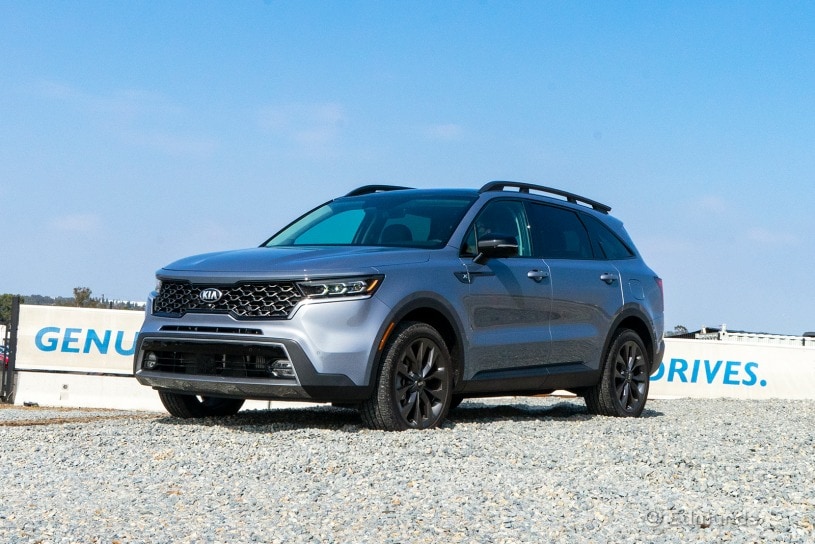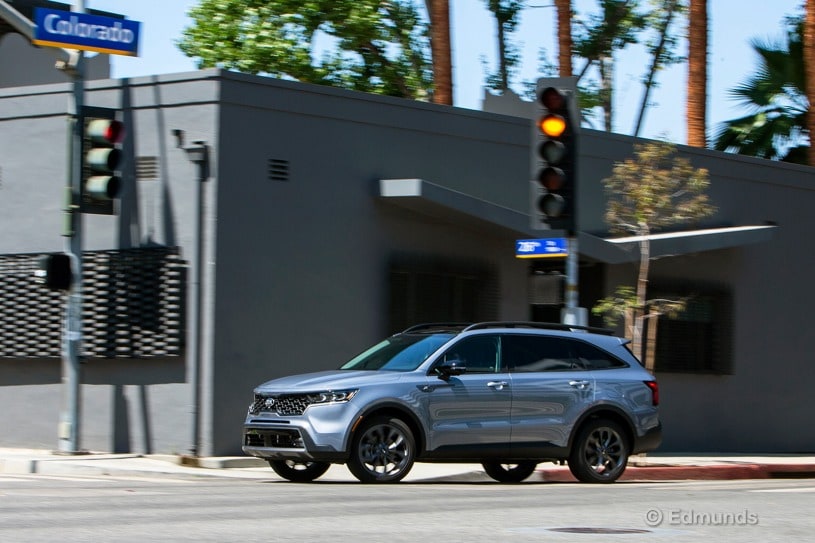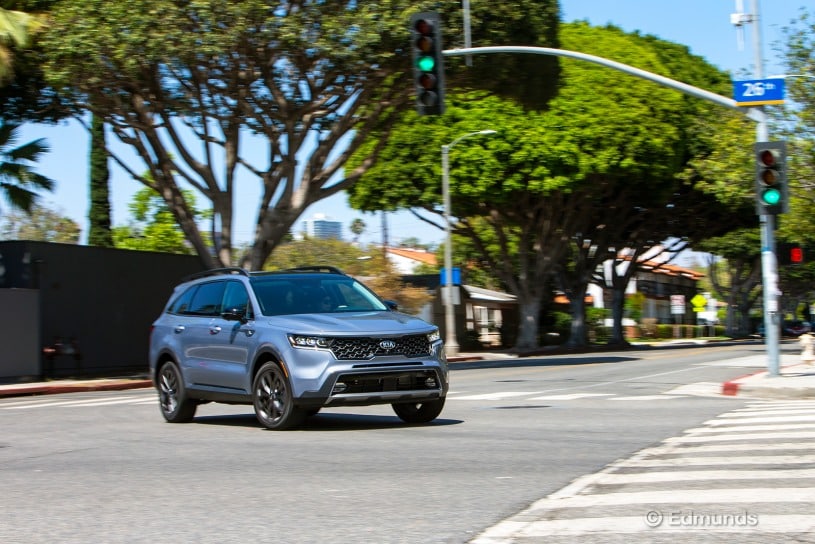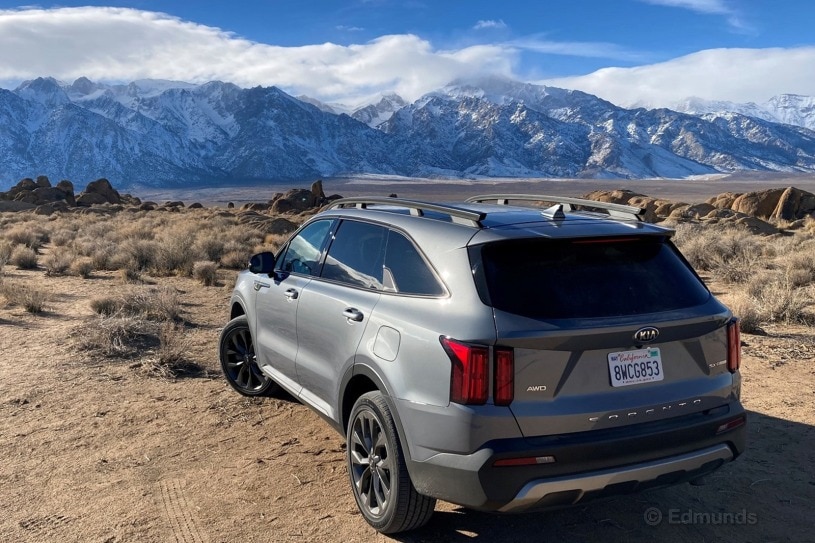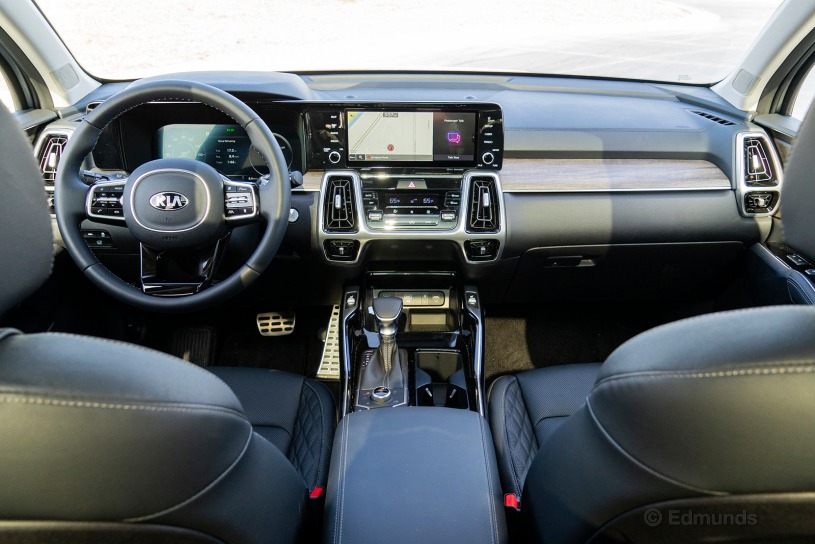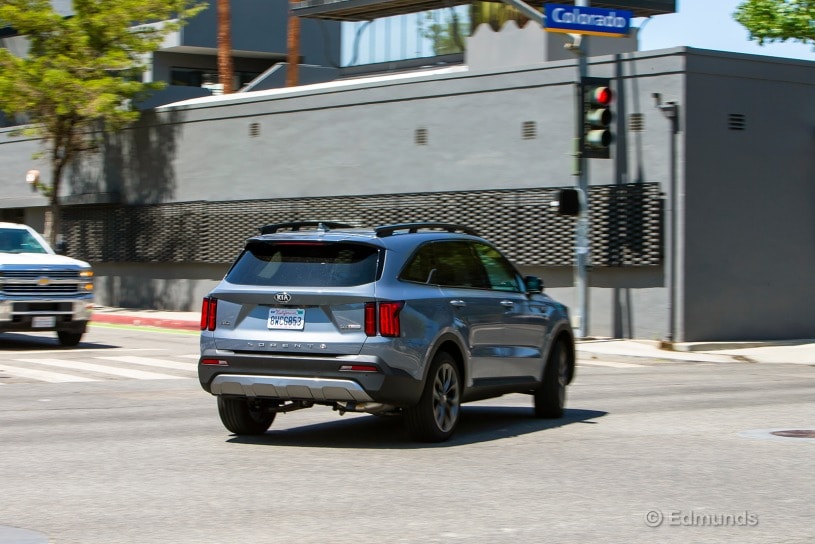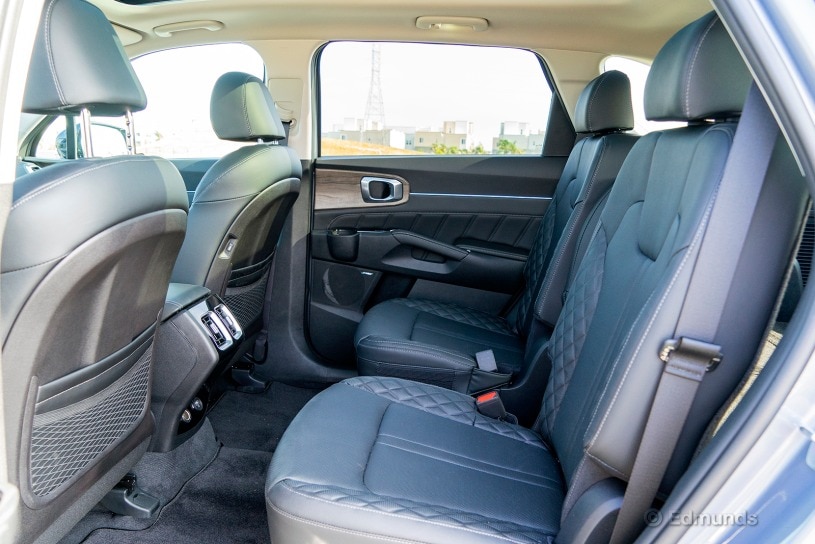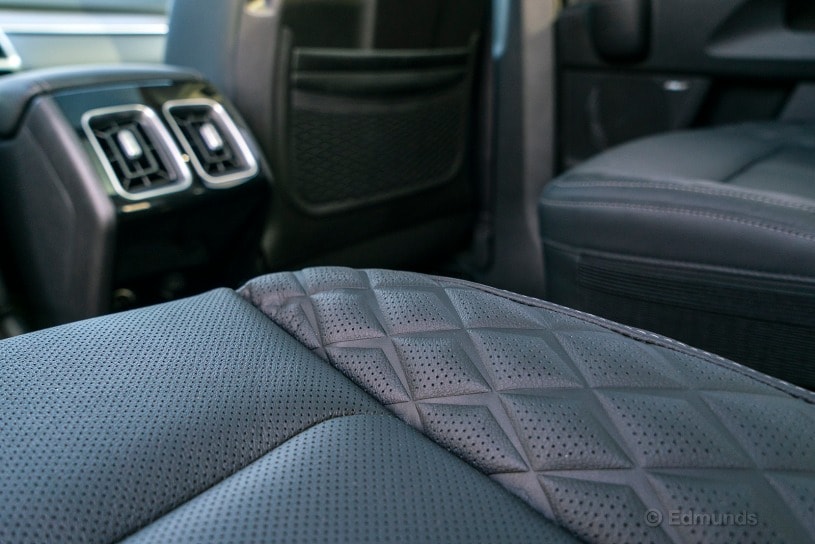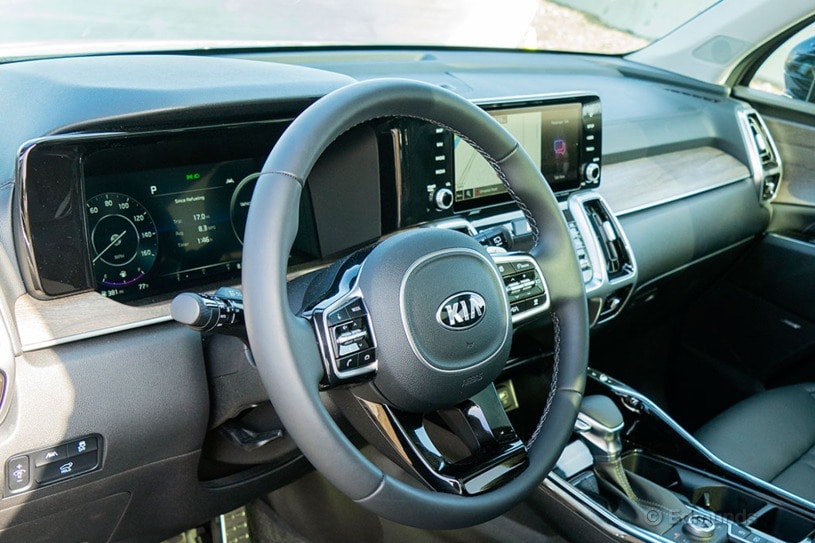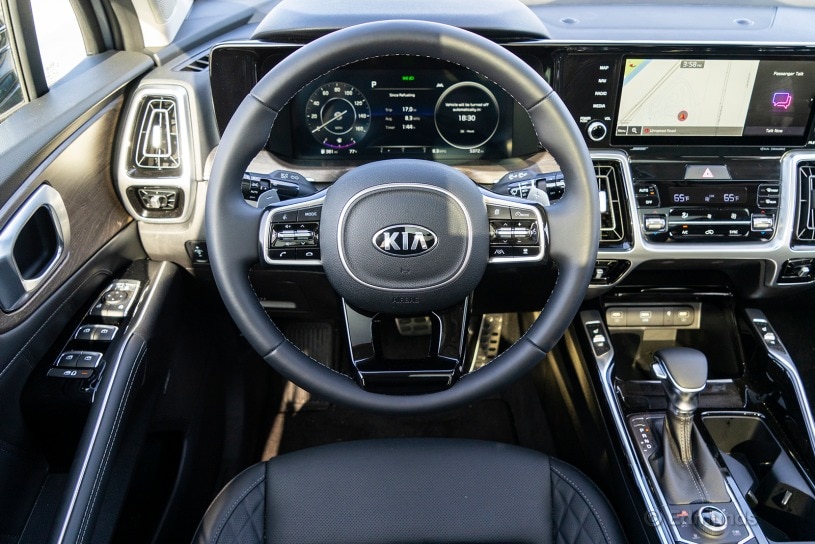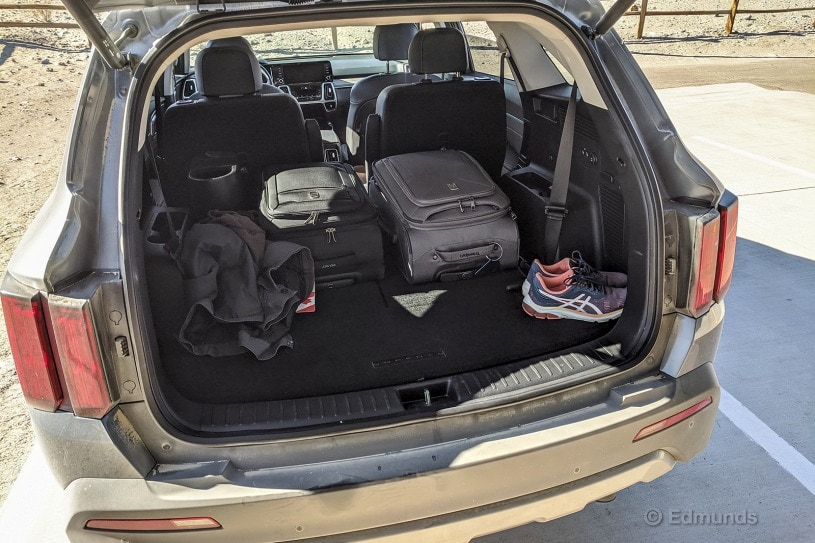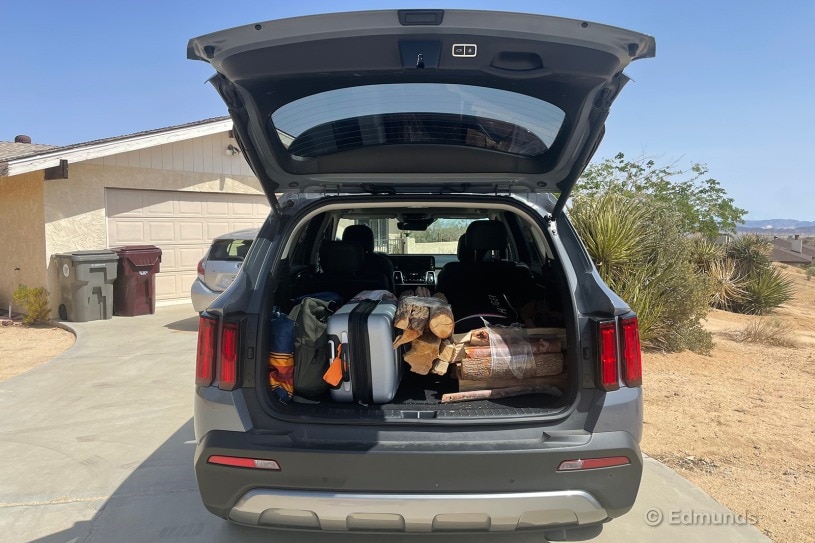2021 Kia Sorento: What's It Like to Live With?
The 2021 Kia Sorento X-Line is an impressive small three-row SUV, but there's a lot of competition in the small crossover class. We spent a year with one to see how it fares
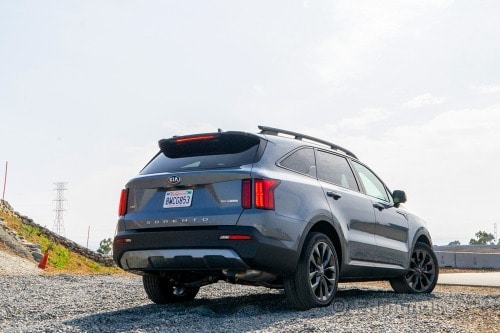
| Final Miles Driven | Average MPG |
| 23,168 | 22.8 |
Overall Highlights (updated 10/03/22)
- Three rows of seating and excellent cargo space for the class
- Spacious interior let down by mixed opinions on seat comfort
- Impressive suite of available in-car tech, driver aids and safety features
- Turbocharged engine provides plenty of power but underwhelms when it comes to the gas pump
- We never once hit the EPA highway fuel economy rating
What do you want to know about?
• Our test vehicle: 2021 Kia Sorento X-Line SX Prestige
• Base MSRP: $43,765
• MSRP as tested: $44,090
The image of Kia as a budget automaker is a thing of the past. Each new vehicle the South Korean automaker churns out builds on the strengths of the last. Kia has expanded on its core values — lots of features and a long warranty for less money than its rivals — with sharp styling, premium and upscale interiors, and comfortable yet engaging driving dynamics.
Take our long-term 2021 Kia Sorento X-Line SX Prestige. The Sorento is a small three-row SUV that sits between the Sportage and the Telluride in Kia's lineup. Until the latter arrived, the Sorento was the largest model in Kia's lineup. The Telluride is an Edmunds favorite, topping our midsize three-row rankings when it debuted in 2020. At first blush, it seemed the Sorento took what we love about the Telluride and distilled it into a smaller package. We were so impressed with the Sorento when it debuted that we had to add one to our long-term fleet.
What Did We Get?
There was a lot to consider with the Sorento, from updated in-car tech to a new turbocharged inline four-cylinder engine that promised to be both more powerful and more fuel-efficient than the outgoing Sorento's V6 engine. Because we wanted a chance to sample all of the Kia's new features, we opted to order a Sorento SX Prestige with the X-Line appearance package. With an as-tested price of $44,090, it was the most expensive trim in the Sorento lineup.
We had six trims to choose from: LX, S, EX, SX and SX Prestige. Standard features included LED headlights, an 8-inch touchscreen display with Apple CarPlay and Android Auto smartphone integration, a smattering of USB ports, and keyless entry with push-button start plus driver aids like automatic emergency braking and lane keeping assistance.
Our loaded X-Line model included quite a bit more. The turbocharged engine raised output to 281 horsepower and 311 lb-ft of torque. That's nearly as much horsepower and far more torque than even the Telluride's V6 engine. The extra power made a difference: The Sorento out-accelerated Edmunds' long-term Telluride at our test facility.
The X-Line SX Prestige also had 20-inch wheels, a 10.25-inch touchscreen display with navigation, a wireless phone charger, dual-zone automatic climate control, a panoramic sunroof, a power liftgate, a digital instrument cluster, leather upholstery, heated and ventilated power-adjustable front seats, and a Bose audio system. Driver aids such as blind-spot warning with rear cross-traffic warning, adaptive cruise control, parking sensors and a surround-view monitor also made the cut. The X-Line package added all-wheel drive as well as a few visual tweaks like a matte finish to the wheels and different front and rear bumpers.
Why Did We Get It?
The previous Sorento was a fine but unexceptional crossover, offering more passenger space than its rivals but not excelling anywhere else. The 2021 Sorento was a vast improvement, making it Edmunds' favorite small three-row SUV. But the Sorento wasn't quite the deal it once was, with prices that put it in competition with larger, more capable SUVs, including Kia's own Telluride. Edmunds had just wrapped up a year with the Telluride before the Sorento arrived. The Telluride continued to impress us even after more than 20,000 miles. At first, the Sorento reminded us a lot of the Telluride and we wanted to know how it would measure up after 20,000 miles of its own.
What Did We Learn?
The Sorento, just like the Telluride, was a staff favorite. We had no problem hitting our 20,000-mile goal in part because it's a lot of fun to drive. The turbocharged four-cylinder engine is a blast, supplying plenty of power to the three-row SUV.
We were less enthusiastic about the transmission, which took its fair share of criticism for being sluggish while upshifting from low gear and while downshifting from any gear. That and the so-so fuel economy ended up as our biggest, or at least our most frequent, complaints. We ended up at 22.8 miles per gallon, not far from the 24 mpg combined cited by the EPA but not close to the 28 highway mpg claimed by the organization — and we spent plenty of time on the highway.
And we spent so much time in the Sorento because of its standout utility and versatility. It was routinely praised for its storage (the fold-down third row, in particular) and its technology. It became a go-to vehicle for camping trips, road trips and trips to the grocery store because of its reliable, easygoing charm.
What's the Bottom Line?
The Sorento may not boast the same comfort, class or size of the Telluride, but it does come with a lot of what we love about the latest generation of Kia vehicles. The interior is well-crafted and offers a touch of luxury at a reasonable price, while the driving experience is surprisingly sporty for a midsize SUV. The Sorento does everything you need and occasionally offers a little more.
2021 Kia Sorento: Real-World Fuel Economy
Considering how many highway miles we've put on the Sorento, just meeting the EPA combined rating is a bit disappointing.
Final average lifetime mpg: 22.8
EPA mpg rating: 24 combined ( 21 city / 28 highway )
Best fill mpg: 26.3
Best range (miles): 423.6
Current odometer: 23,168
We never once hit the EPA fuel economy rating despite lots of highway driving
"In the last update, I talked about the Sorento's overall comfort on a several thousand-mile trip to go see family. While the seat was a bit stiff, I'm blaming it on the car being brand-new and not broken in quite yet. Subsequent drives were much better.
"As much as I enjoyed the ride, I was disappointed by the Sorento's fuel economy. Our model uses Kia's 2.5-liter turbocharged inline-four that makes 281 horsepower and 311 lb-ft of torque. It's peppy and smooth, and its EPA-estimated fuel economy of 24 mpg combined (21 city/28 highway) is pretty good for an updated engine. But even in ideal conditions (moderate ambient temperature, zero passengers for less weight and a slight downhill grade), the best I saw on the trip to see my mom was 26.8 mpg. That's the only time the Sorento has exceeded 26 mpg in its entire time in our hands.
"This is particularly noteworthy given that our long-term Kia Telluride had lackluster fuel economy, too. Both vehicles have enough pros and virtues that we're willing to overlook the middling returns. Still, it's something to note when many rivals are getting upwards of 30 mpg." — Reese Counts, vehicle test editor
"We notched our most efficient tank of fuel ever while crossing the 20,000-mile threshold, which feels like a big achievement. The downside? We still haven't touched the EPA-rated 28 highway mpg on a single tank. And trust us, we have done a lot of highway driving in the Sorento in a handful of different conditions. The overall mpg has underwhelmed regardless of the EPA rating." — Jake Sundstrom, editorial assistant
The Sorento's 2.5L turbocharged four-cylinder didn't do our fuel economy any favors ... but it's fun to drive!
"This thing is actually really fun to drive. Being smaller and lighter than our old Telluride helps the Sorento drive a bit better, change direction quicker in the corners, and feel sportier on the road. The turbocharged 2.5-liter four-cylinder is peppy as hell too. This might be part of the reason our fuel economy is a bit below the EPA estimates right now too — it encourages some pretty enthusiastic driving if the right road is beneath you." — Travis Langness, reviews editor
"The 2.5-liter turbocharged four-cylinder engine in our Sorento isn't the most refined engine of its kind but, man, it hauls the mail. Driving around in the Death Valley region, there are a lot of arrow-straight two-lane roads with plenty of opportunities to pass, and the Sorento turbo was always up to the challenge. I was actually surprised to see that this 2.5T is rated at 'only' 281 horsepower — I would have believed 300-plus. Also, although I've carped about the low-speed behavior of the dual-clutch transmission, I must say that whenever I planted my foot to pass, the gearbox was responsive and drama-free. I haven't driven the Sorento with the standard non-turbocharged four-cylinder, but no doubt there's a world of difference in terms of passing power. If you care about that sort of thing, the turbo is a no-brainer. You gotta have it." — Josh Sadlier, director, content strategy
What did the team think of the transmission?
"I took the Sorento for a long weekend with the family to Las Vegas recently. This was my first time really driving it outside of instrumented testing at the track, where I thought it was pretty fun to drive. I have to admit, I didn't really like it. The 2.5T engine makes great top-end power but it lacks the smooth low-end torque I'd want in a family sedan. I would trade 30 horsepower on the top end for 30 lb-ft more off the line in a heartbeat.
"I'm also not very impressed with the transmission in slow-speed driving. Every time you creep to a stop you can hear the clutches disengaging. In low-speed traffic, it becomes something to fixate on until it begins to drive me mad. I think this needs to go back to an automatic transmission." — Jonathan Elfalan, director, vehicle testing"I'm a fan of the way the Sorento drives — except for one irritating habit. In normal everyday driving, when you leave from a stop, there's a serious hiccup from the eight-speed automatic transmission between first and second gear. It's slightly less annoying from second to third, at which point it smooths out. I tried everything, and here's what I found: The hitch is most pronounced when the drive mode is set to Smart, Eco or Comfort. If you keep it in Sport mode, the problem is far less pronounced. But who wants to drive their family SUV around in Sport mode all the time? I also find it ironic that Smart mode seems to be the worst offender of the three." — Ryan ZumMallen, reviews editor
"A few recent test drives in Volkswagen GTIs with the seven-speed DSG dual-clutch automatic transmission have given me a new appreciation for our long-term Sorento. I'll spare you most of the minutiae, but in short, I've observed that the seven-speed DSG that replaced the GTI's old six-speed DSG for 2019 has lost some of its predecessor's responsiveness and precision. In particular, there's a noticeable delay now in the GTI when you floor it, like the transmission needs an extra beat to think before it finds that lower gear. Would you rather have a dual-clutch automated manual that *doesn't* need an extra beat to think? Consider the turbocharged Sorento. I spent a few weeks with the Sorento as my daily driver, and I can tell you that this Kia out-GTIs the GTI when it comes to quick downshifts for passing. Punch the go pedal in the Sorento at speed and BOOM, the transmission downshifts to the right gear and you're off. It's close to instantaneous. The GTI *used* to perform like this, but the seven-speed DSG has added some unwanted dullness. Kudos to Kia for really going for it with this dual-clutch transmission, even if it could still use some work on smoothing out acceleration from a stop." — Josh Sadlier, director, content strategy
"There's always a key question with any automated manual transmission: Does it smoothly handle the initial takeoff from a stop, or does it feel like you've hitched a ride with a teenager learning to drive? Not that kids learn on manuals anymore, but in any case, I'm afraid our Sorento's dual-clutch automatic is stuck in driver's ed. From a stop, it hesitates when you squeeze the throttle, and then when you naturally react by squeezing some more, it's suddenly ready to go and you're bucking and lurching your way up to speed. After a few days I got to a point where I could modulate the throttle to minimize the issue, but it reminds me of the 'Don't make me think' mantra in the world of web design. The problem with the Sorento's transmission is that you have to think about how to smooth out those starts. The best dual-clutch transmissions do the thinking for you." — Josh Sadlier, director, content strategy
How about the brakes?
"This is a very specific use case, but one I think will resonate with folks in neighborhoods with lots of kids around. I have a long, RV-sized driveway, which we share with our neighbors who have four children. And the drive backs up to a busy street for cyclists. So there are constantly people swirling around the driveway I use multiple times a day. When I'm backing down in any vehicle I am always riding the brake, just in case some unforeseen pedestrian pops out behind me. My issue is that the Sorento doesn't allow you to creep. Keep a light foot on the brake pedal and the vehicle will come to abrupt stops, so I'm constantly doing the stop-and-go dance down my (again) very long driveway. Other SUVs will allow you to gracefully back up at a slow speed, avoiding pedestrians and looking like you've driven a car before at the same time. The Sorento makes you choose one or the other." — Ryan ZumMallen, reviews editor
"Here's an issue that many Sorento drivers may never encounter, but it matters. Imagine you're driving down a steep mountain grade and you've manually selected a lower gear to maximize engine braking, but it's not enough. You're going to have to ride the brake. In this scenario, the last thing you want is obviously brakes that don't work at all, but the *second-to-last* thing you want is shuddering brakes that shake the whole car even with modest pedal pressure. And that, friends, is how our Sorento's brakes behaved as I made my way down the slope from Lone Pine, California (elevation 3,700 feet), to Death Valley (elevation, well, you know). I'm not exaggerating — the whole structure was shaking, not just the pedal. On flat ground, it would be a unmistakable case of warped rotors, but our Kia brakes just fine ordinarily. I also checked our track test from the 5,370-mile mark and saw that the car stopped from 60 feet in an admirably short 119 feet, earning positive comments from our driver in the process. He did note 'a good amount of ABS pulsing,' but that's in a panic-braking condition, i.e., full pedal pressure. Descending into Death Valley with about 12,000 miles on the odometer, the Sorento got the shakes even if I pressed the pedal as lightly as I could. I can't imagine what could be causing this, and I'm not saying it's a safety issue. Bottom line, the brakes were still doing their primary job of slowing the car when asked. But it was definitely disconcerting. You want to feel confident that your brakes will perform flawlessly even in extreme situations, and that's not what I was feeling on my way through Star Wars Canyon and the Towne Pass." — Josh Sadlier, director, content strategy
"UPDATE: Brakes are shuddering even on normal-ish descents, like the winding downhill section of 101 North from Newbury Park to Camarillo. Light pedal pressure = full-body shaking. Must be rotors, right? But at 14K miles? What gives, Kia?" — Josh Sadlier, director, content strategy"In general, I'm quite impressed by the Sorento's level of refinement. At highway speeds, it's smooth and quiet on the road — mostly. The one exception, though, is wind noise, and I find that annoying, especially in a vehicle with premium pretensions. Get the Sorento out of the friendly confines of the city and you'll find that crosswinds and headwinds produce a lot of hissing around the top of the windshield. If a glass guy had just installed this windshield as a replacement, I'd be calling him to report that something must not be right. To an extent, the Sorento is a victim here of its overall quietness, which makes the hissing more noticeable. But at our test car's MSRP of $44,090 with destination, intrusive wind noise shouldn't be on the menu." — Josh Sadlier, director, content strategy
"Three days after the Sorento arrived in our hands, I took a road trip to visit my mom in Missouri. Sure, it would be much easier and quicker to fly, but I was eager to take a big road trip after being stuck at home for more than a year. I ended up putting nearly 4,000 miles on the Sorento over the span of about 10 days, though the majority of that was done over four long days of driving.
"For the most part, the Sorento didn't let me down. I made the drive in two days, stopping overnight in Denver. A mudslide on I-70 on the way out added a multi-hour detour over some dirt roads somewhere near Glenwood Canyon (one of the most scenic stretches of road in the country). I was wiped after I arrived in Denver. The Sorento's ride is great, even with our X-Line model's off-road package. It doesn't wipe out every imperfection, but it does a good job of isolating them. It's quiet, too. Kia and Hyundai have been killing it when it comes to interior noise levels. The Sorento is quieter than many luxury cars we test, a testament to how far Kia has come.
"My biggest complaint in terms of comfort is the driver's seat. By the time I stopped for the night, my lower back was killing me. Just stiff and sore. I'd tried adjusting my driving position, but I think the padding is just too stiff. Hopefully that gets better the more we drive it. Now, I was doing some very long stints behind the wheel, stopping only when I needed fuel (more on that later). Still, that's my M.O. on road trips, and this is the first time I've felt this stiff.
"That said, it wasn't enough to keep me from planning to do it all again." — Reese Counts, vehicle test editor
"The Sorento is an excellent road trip companion. It's quiet, comfortable on the highway, and it has great seats. A buddy of mine recently bought a Sorento because the dealership didn't have any Telluride availability, and he's totally happy with the decision — I can see why. For a growing family with a couple of kids, you don't need the Telluride to get all that comfort. This smaller, less expensive Sorento is just as good, albeit with a little less space." — Travis Langness, reviews editor
Not all of us on staff loved the Sorento's seats
"Our director of vehicle testing, Jonathan Elfalan, spent over six hours straight behind the wheel of the Sorento. "I can say with certainty that it is not as comfortable as the Telluride. The seat cushions are the first thing you notice as they feel a bit flat and lack support. I didn't think the Telluride had the greatest seats but they were definitely more comfortable. The Sorento also has a somewhat stiff ride. It handles surprisingly well when you hit the twisty roads but you pay for it when the road surfaces are a bit bumpy.
"If you value comfort and don't mind its larger size, I'd recommend the Telluride over the Sorento every time. So would my family."
"The Sorento became a go-to road trip vehicle while in our care with mixed results. Vehicle Test Editor Reese Counts put more miles on the Sorento than anyone else on the team, and he, like Jonathan, became less impressed with the Sorento's seats over time.
"I've spent a lot of time in the Sorento since it arrived," he said. "Maybe more than any other long-term vehicle before it. There's a lot to like with the Sorento, but I've become less enamored with it over time. After a few hours behind the wheel, my lower back starts killing me in a way that doesn't bother me in other cars. When it first arrived, I figured that maybe the seat hadn't broken in yet (it was brand-new) or that I just hadn't found a good driving position. That hasn't been the case. It's a bummer, but combined with the poor fuel economy, this doesn't make a very great road-trip car."
Creative Services Projects Manager Carrie Kim, on the other hand, enjoyed the luxury appeal of the Sorento on her recent road trip through the interior of California.
"I was really surprised by how nice the interior cabin was," she said. "Between my ventilated seats, multiple cupholders, pano moonroof and Bose sound system, I wasn't wanting for much more during my drive to Central California and back. It was a solo sanctuary for me and much nicer in there than I was expecting."
Maintenance Summary
| Total routine maintenance costs | $446.24 |
| Additional maintenance costs | |
| Warranty repairs | |
| Non-warranty repairs | |
| Scheduled dealer visits | 1 |
| Unscheduled dealer visits | |
| Days out of service | |
| Breakdowns stranding driver | |
| Total body repair costs |
So how was the service experience with Kia?
"The Sorento gave us a notification for service at 15,000 miles, so I took a trip to Kia of Irvine and asked for the '15,000-mile service package.' That ran me $446.24, with $225.98 billed for the labor, $66.96 tacked on for 6 liters of oil (0W-30 synthetic), $31.90 for the filter, $100.62 for the service package and another $5.32 for the disposal of the old oil. Oh, and $15.46 for tax. The service was completed quickly and fuss-free.
"That seemed like a steep price, so I took a look at the manual when I got home and found the manufacturer recommended service for the interval (the Sorento calls for service every 6,000 miles). The 12,000-mile service interval includes an oil change, fuel additive (Kia recommends you use 91 octane gasoline ... or, get this, additive every 10,000 miles) and a new cabin air filter. A quick call back to the service center for a price quote revealed a pretax total of $160. Let my mistake save you money: Read the manual. Ask for the parts and service you actually need when you need them and you'll be better for it. Or you'll have slightly more money, anyway." — Jake Sundstrom, editorial assistant
Any quirks in the system?
"The Kiassance, sorry, sorry, I'm trying to remove it, has largely been driven by great, intuitive technology. So, it's surprising (and a little frustrating) that the steering wheel, uh, song-skipper(?) is the exact opposite of that. Flick the button up ... and guess what? You're listening to Taylor Swift's 'Blank Space' again.
"This is the only vehicle I've driven that seems directionally challenged in this way, but I'm willing to accept that I don't know which way is up and which way is down entering the third year of a global pandemic. Maybe I *am* the one that's so out of touch." — Jake Sundstrom, editorial assistant
OK, anything else?
"You're a great listener. The blind-spot detection is great at sensing cars in lanes right next to you. Sounds awesome, right? Here's the problem. When you're merging, it continues to look for vehicles (or objects) in the soon-to-be adjacent lane. So, you might be halfway through your merge and you'll get a (very) loud alarm signaling your impending collision ... because there's a vehicle a full lane over. Better safe than sorry? Absolutely. But this is safety technology that falls on the wrong side of sensitive — and unfortunately, there doesn't appear to be a way to dial it back." — Jake Sundstrom, editorial assistant
"Don't assume wireless charging = wireless Apple CarPlay/Android Auto. You'll still need to plug in to access the smartphone integration. The Sorento offers a pair of USB-A plugs underneath the center control area, one of which is designated as the smartphone plug (it says 'USB' above it)." — Carrie Kim, creative services project manager
What about all this great standard safety technology we keep hearing about?
"I was very impressed by the Sorento's adaptive cruise control and lane keeping assist. I use adaptive cruise control regularly in my personal vehicle for those grueling L.A. freeway commutes. The system wasn't jerky or abrupt — it handled accelerations and braking smoothly and better than most other ACC systems I've used. Combined with the lane centering, it made the round trip to Central CA and back quite relaxing." — Carrie Kim, creative services project manager
How much cargo space does the Sorento really have?
"You'd think that a compact three-row SUV would at least count cargo space as a strength over other compact SUVs. And you'd be right. On a recent camping trip we folded down the third row, plus slid the second row forward a touch to create a ton of room for our supplies. Here's what we packed in there: two tents; three sleeping bags; three folding chairs; 40-quart cooler; portable stove; blankets and blankets and blankets. And we had room to spare. I especially liked the width of the trunk space, which you might not expect because the opening itself is a little tight. Now of course, if you need to seat people in all three rows you'll lose this advantage. But for those who need all three rows occasionally — or not at all — it's a treat." — Ryan ZumMallen, reviews editor
A trip to Joshua Tree gave an Edmunds staffer a chance to try out the cargo capabilities of the Sorento: "In terms of loading cargo in the rear, it was a breeze. I'm 5-foot-7 and the rear cargo floor reaches just below my hip. That being said, loading and unloading is effortless. I like to make fewer trips back and forth when I'm loading and unloading my gear. Having the tailgate open and close at the push of a button made it so much easier."
